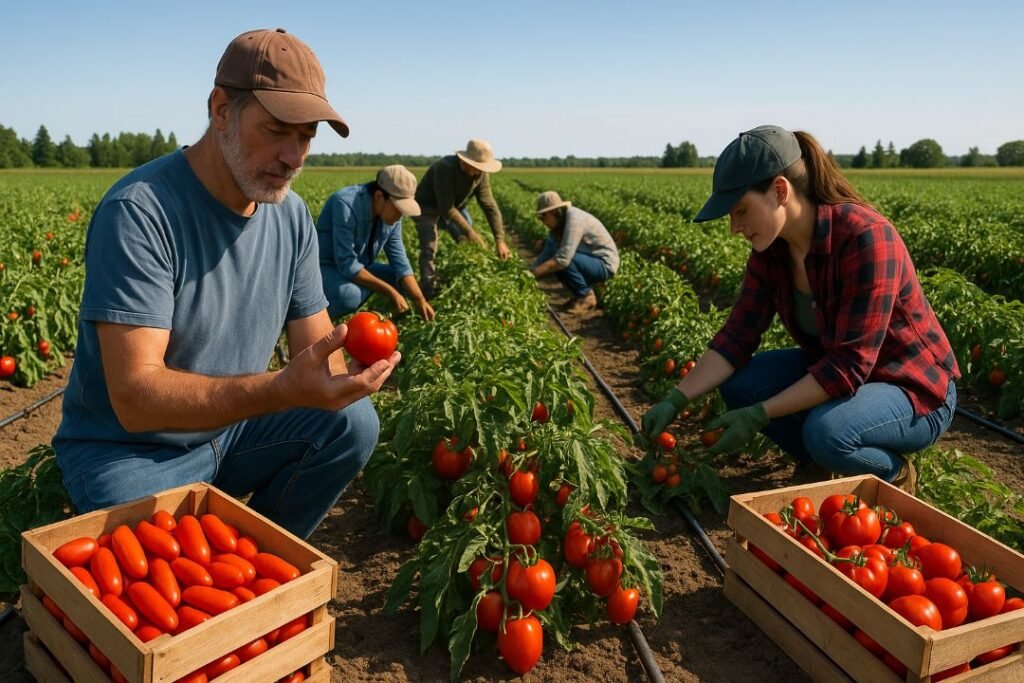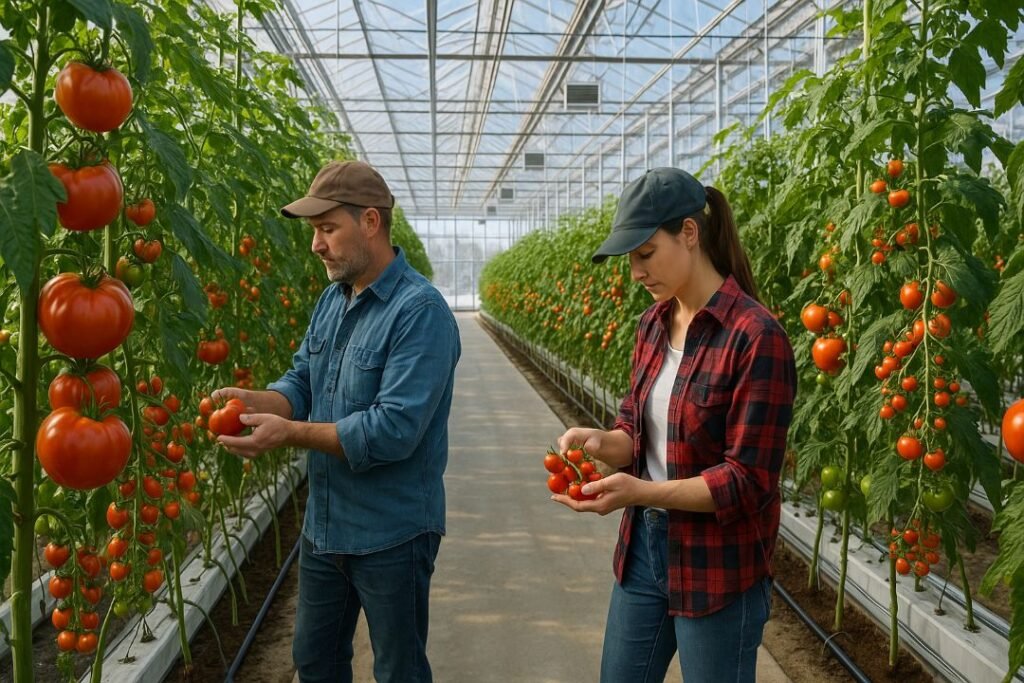Introduction
Are you considering a venture into commercial tomato farming in Canada? With rising demand for fresh, locally grown produce, tomato farming is emerging as a profitable business opportunity. In recent years, greenhouse production has surged, fueled by consumer preference for year-round, high-quality tomatoes. According to Statistics Canada, greenhouse tomato production reached 314.91 million kilograms in 2023, reflecting robust local demand. This tomato farming guide for Canada will cover everything you need to know—from planning and costs to varieties, yield, and sustainable practices—to help you succeed in this thriving industry.

Why Tomato Farming Is Profitable in Canada
Tomato farming in Canada offers significant profit potential due to strong market demand. In 2020, fresh market tomatoes were the top greenhouse vegetable, with 256.4 million kg produced, valued at $665.9 million. Consumers increasingly seek local and organic produce, driving up the market price of tomatoes in Canada, which varies by province—highest in Newfoundland and Labrador at $7.33/kg and lowest in Ontario at $5.50/kg in 2020. Moreover, the trend toward sustainable, locally sourced food boosts tomato farming profit in Canada, with profit margins often enhanced by value-added products like sauces and sun-dried tomatoes. As a result, savvy farmers can capitalize on this growing market.
Ideal Conditions for Growing Tomatoes in Canada
To succeed in tomato farming in Canada, understanding ideal growing conditions is crucial. Tomatoes thrive in warm climates, with optimal daytime temperatures of 70-85°F and nighttime ranges of 65-70°F. In Canada, planting is best in late spring (May to June) after the frost risk subsides. Soil should be well-drained, loamy, and slightly acidic, with a pH of 6.2 to 6.8.
- Climate Zones: Southern Ontario, British Columbia, and parts of the Prairies are ideal due to milder weather.
- Soil Type: Sandy loam or loamy soil with good drainage is preferred.
- Greenhouse vs. Open-Field: Greenhouses extend the season and control conditions, while open-field farming suits warmer regions but faces weather risks.
These tomato plant conditions in Canada determine the best tomatoes for Canada, balancing climate and soil adaptability.
Choosing the Right Tomato Varieties for Commercial Farming
Selecting profitable tomato varieties in Canada is key to success. High-yielding, disease-resistant options suit Canada’s climate and market needs. Popular choices include:
- Beefsteak: Large, juicy, ideal for fresh markets.
- Roma: Firm, great for processing into sauces and pastes.
- Cherry: Small, sweet, perfect for salads and specialty markets.
For tomato varieties for greenhouse farming in Canada, consider indeterminate types like ‘Trust’ (widely used in the U.S. and adaptable here) or ‘Dombito’ and ‘Belmondo’ for areas west of the Cascades. Disease-resistant varieties, such as those with tolerance to Verticillium and Fusarium wilt (VF1,2), are essential for consistent yields. Consult seed catalogs and local buyers to match varieties to demand.
Step-by-Step Guide to Tomato Cultivation in Canada
Land Preparation and Soil Management
Proper land prep sets the foundation for tomato farming in Canada. Start with soil testing to check pH and nutrient levels. Then, incorporate compost or well-rotted manure to enrich soil. Tilling to 60 cm improves aeration and drainage.
- Organic Prep: Use compost and natural amendments for sustainable growth.
- Conventional Prep: Apply synthetic fertilizers like DAP or TSP based on soil test results.
Seed Selection and Germination
Most commercial growers start with hybrid seeds indoors. For Canada’s cooler climate, use greenhouse-grade heating mats to maintain a rootzone temperature of 84°F for faster germination.
- Seeds vs. Seedlings: Certified seeds cost ~$0.18 per seed (based on Kenyan rates, adjusted for Canada), or buy seedlings at ~$0.04 each.
- Germination Tip: Keep soil moist but not waterlogged; expect sprouts in 4-6 weeks.
Transplanting and Plant Spacing
Transplant seedlings at 4-6 inches tall, typically in May after frost risk. Space plants 18-24 inches apart in rows, with 4-5 feet between rows, to optimize yield and airflow, reducing disease risk.
Fertilization and Nutrient Management
A solid fertilizer schedule for tomatoes ensures healthy growth. Tomatoes need nitrogen (N), phosphorus (P), and potassium (K).
- Initial: Apply 50 kg NPK per hectare at planting.
- Top-Dressing: Use CAN or urea at 4 weeks, then NPK at 8 weeks post-transplant.
- Foliar Feed: Apply during flowering to boost fruit set.
Irrigation Methods
Watering tomatoes correctly is vital for healthy plants and big yields in tomato farming in Canada. Research shows drip irrigation is the best choice for most growers. A 2021 study from the University of Guelph in Ontario found it increases tomato yield by 20-30% compared to older methods like furrow watering. Here’s how to do it simply:
- What is Drip Irrigation?
This method uses tubes to deliver water straight to the plant’s roots. It saves water and keeps leaves dry, which helps stop diseases. - How Much Water?
- Open Fields: Give each plant 4-6 liters of water daily. Water every 2-3 days in summer, depending on rain. Aim for 25-50 mm of water per week, per the University of Guelph (2021).
- Greenhouses: Water mature plants in short bursts—12 or more times a day—using less water each time to keep soil moist but not soggy.
- Why It Works
- Saves 35% more water than sprinklers, according to 2022 research from Vineland Research and Innovation Centre.
- Reduces weed growth and keeps diseases away by avoiding wet leaves.
- Easy Tips
- Check soil: If it feels dry 2-3 inches down, water more.
- Use mulch (like straw) to hold moisture in the soil.
- Adjust for weather: Water less on rainy or cloudy days.
Source: University of Guelph, “Irrigation Strategies for Tomatoes in Ontario” (2021); Vineland Research and Innovation Centre, “Greenhouse Water Management” (2022).
Pest and Disease Management
Tomatoes in Canada can get sick or be attacked by pests, but you can protect them easily! Field studies by Agriculture and Agri-Food Canada (AAFC) and the Ontario Ministry of Agriculture, Food and Rural Affairs (OMAFRA) show common problems and simple fixes. Here’s what to do:
- Common Problems
- Diseases:
- Early Blight: Brown spots on leaves, caused by a fungus (Alternaria solani).
- Late Blight: Dark, wet spots that ruin plants fast, especially in wet years—15-20% of open-field crops hit, per AAFC (2023).
- Fusarium Wilt: Plants wilt and die from a soil fungus.
- Pests: Aphids and whiteflies are tiny bugs that suck plant sap, damaging up to 10% of yields, per OMAFRA (2022).
- Diseases:
- Simple Solutions
- Prevention:
- Switch crops: Grow corn or beans in the field for 3-4 years before tomatoes to stop disease buildup.
- Pick strong plants: Use varieties like ‘Defiant’ that fight blight.
- Clean up: Remove old leaves and debris to keep pests away.
- Natural Fixes:
- Spray neem oil (from a tree) to cut pests by 25%, per OMAFRA tests (2022).
- Use copper sprays to reduce blight by 30%—safe and organic!
- Easy Checks:
- Look at plants weekly for spots, wilting, or tiny bug eggs under leaves.
- Act fast: If you see trouble, treat it right away to save your crop.
- Prevention:
Source: Agriculture and Agri-Food Canada, “Tomato Disease Survey” (2023); OMAFRA, “Pest Management in Field Tomatoes” (2022).
Greenhouse Tomato Farming in Canada

Greenhouse tomato farming in Canada offers controlled conditions, higher yields, and year-round production. In 2023, Canada produced 314.91 million kg of greenhouse tomatoes.
- Benefits: Reduced pest pressure, extended seasons, and yields of 50-70 kg/m².
- Setup: Use tall structures with ventilation, temperature control (70-85°F), and high-light transmission (70-81%).
- Hydroponic Tomato Farming in Canada: This soilless method boosts yield (up to 80 tons/acre) using nutrient-rich water.
Tomato Yield Per Acre in Canada
Tomato yield per acre in Canada varies by method:
- Open-Field: Averages 4-8 tons per acre, per global data.
- Greenhouse: Reaches 50-70 kg/m², or ~20-28 tons per acre, with top producers hitting over 70 kg/m². Factors like variety, weather, and technology (e.g., CO2 supplementation) impact output. Experienced growers leverage computerized controls for bigger harvests.
Cost of Tomato Farming in Canada
Tomato farming cost per acre in Canada depends on the system. Here’s a breakdown:
| Expense | Open-Field Cost ($) | Greenhouse Cost ($) |
|---|---|---|
| Initial Investment | 5,000 – 10,000 | 20,776 (24×96 ft setup) |
| Seeds/Seedlings | 500 – 1,200 | 500 – 1,200 |
| Fertilizer & Inputs | 1,000 – 2,000 | 1,500 – 3,000 |
| Irrigation Setup | 1,000 – 2,500 | 2,000 – 3,500 |
| Annual Maintenance | 2,000 – 4,000 | 6,396 (depreciation, etc.) |
| Total Per Acre (Approx.) | 9,500 – 19,700 | 31,172 – 34,826 |
Costs vary by region, labor, and scale. Greenhouse setups are pricier but yield more.
Marketing and Selling Your Tomato Produce
Selling tomatoes in Canada requires strategy. Options include:
- Where to Sell: Farmers’ markets, grocery chains, and wholesalers like Highbury Canco.
- Branding: Highlight “local” or “organic” for premium pricing.
- Pricing: The tomato market price in Canada ranges from $5.50/kg in Ontario to $7.33/kg in Newfoundland. Add value with sun-dried tomatoes or sauces for higher margins.
Tips for Sustainable and Organic Tomato Farming
Sustainable tomato farming and organic tomato farming methods benefit both the environment and profits:
- Composting: Use farmyard manure and crop residues to enrich soil.
- Crop Rotation: Rotate with corn or legumes to prevent disease buildup.
- Water Conservation: Drip irrigation and mulching reduce usage.
- Certification: Obtain organic labeling through Canada’s Organic Standards for credibility.
Conclusion
Commercial tomato farming in Canada offers a lucrative opportunity if planned well. From choosing the right varieties and mastering soil, irrigation, and pest control to leveraging greenhouses for higher yields, this guide covers it all. By starting small, optimizing costs, and marketing smartly, you can scale profitably. Ready to grow tomatoes commercially in Canada? Start planning your 2025 season now!
FAQ
- What is the most profitable tomato variety in Canada?
Varieties like Beefsteak and Roma are profitable due to high yield and demand for fresh and processed markets. - How much can I earn from tomato farming per acre?
Earnings vary; open-field may yield $20,000-$40,000 per acre, while greenhouses can exceed $100,000 with premium pricing. - When is the best time to plant tomatoes in Canada?
Plant in May or June, after the last frost, for optimal growth. - Is greenhouse tomato farming more profitable than open field?
Yes, greenhouses often yield higher (20-28 tons/acre) and fetch better prices due to quality and consistency. - What equipment do I need to start tomato farming in Canada?
Basics include tillers, drip irrigation, stakes, pruning tools, and, for greenhouses, ventilation and heating systems.
Useful Links
Explore these trusted resources to boost your success in tomato farming in Canada:
- Statistics Canada – Greenhouse Vegetable Production: Find data on tomato production and market value.
- University of Guelph – Irrigation Research: Learn about drip irrigation benefits for tomatoes.
- OMAFRA – Tomato Pest and Disease Guide: Practical tips to manage pests and diseases.
- Agriculture and Agri-Food Canada – Crop Resources: Research and stats on tomato farming.
- Canada Organic Standards: Steps to certify your farm as organic.